 |


Wim Botha
'commune: onomatopoeia', 2003
Installation view

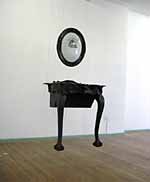
Wim Botha
'commune: onomatopoeia', 2003
Installation detail

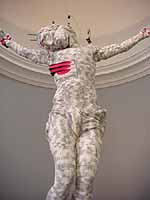
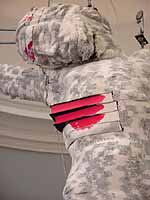

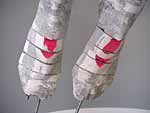
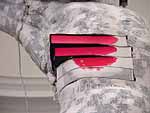
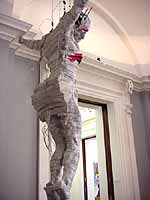
Wim Botha
Commune: suspension of disbelief, 2001
Carved Bibles, Biblical Text, Surveillance Equipment
Installation Dimensions Variable, Figure Life-size


Wim Botha
Carbon Copy (Madonna Del Parto Col Bambino), 2002
Anthracite, Epoxy Resin, Liquid Petroleum Gas, Copper, Steel
Installation Dimensions Variable, Figure 1metre high


|
 |
 |
 |

Wim Botha
by Sean O'Toole (April, 2003)
|
 |
 |
 |
 |

Wim Botha grew up in a drowsy suburban neighbourhood on the eastern reaches of Pretoria. This fact might not necessarily be apparent the first time you view his work, but it is relevant. His work is rooted in the officious pretensions of the nation's administrative capital, and draws extensively from popular iconography closely associated with the city. Seemingly boring stuff like trophy mounts and government texts, bibles and religious icons have all at some time or another been the form and/or content of his visually arresting output.
Using the familiar, the everyday, the iconic, Wim Botha has succeeded in creating works characterised by their delicate blending of inter-acting themes. Take for instance his Wild Life series of sculptural installations. A relatively early piece from his career, Wim Botha used official government gazettes as source material for a carved bust of a Blue Wildebeest. As in much of the work that followed, the carved text of this piece became the physical substance of the work, the collective text informing both the representation of the work, as well as providing the work with its social context.
"My works are a process of distillations," the artist explains. "They attempt to reduce all-encompassing ideas and universal factors down to their core idea." Exploring along the way "intercepting variables" and "patterns", his work also offers viewers a curious glance at "the things people do, need, construct to make sense of things," be they grandiose and religious, or decorative and facile in a not so innocent fashion.

|
 |
 |
 |
 |

"Botha has a knack of disguising quite radical content under the veil of traditional form. "
"Paper, inexpensive as it is, gains value and power as a carrier of information, not unlike Joseph Beuys's famed Batteries - a series of stacked newspapers. Likewise, Botha's use of a dietary staple to represent a religious icon in the Mieliepap Maria acts as a metaphor for the spiritual sustenance that faith offers."
Kathryn Smith, M&G, April 6, 2001
"Wim Botha's 'Transmigrations' sculptures are carved out of prison release papers and other documents that regulate human movement. A suspended, androgynous figure, hovering between growth and decay, confronts a Sable head mounted like a trophy, thus contrasting ideas of freedom and classification and evoking the spectre of death."
Paul Edmunds, ArtThrob, www.artthrob.co.za/02apr/reviews/kknk.html

|
 |
 |
 |
 |

Kathryn Smith once commented that Wim Botha's work is concerned with "familiar icons and objects that speak about belief, faith, observation, transgression and forgiveness." When asked about this assessment, Wim Botha agreed, tentatively. "There are numerous, varied and sometimes conflicting aspects to my work, usually intended but definitely also spontaneously emerging." One such emerging tendency is the subtle humour and wry sense for the ironic that often (but not always) masks the essential gravity of his work.
Speaking about his working method, the artist has commented: "It is a very deliberate and conscious, even though it is instinctive. My working method is not mystical in any way. I enjoy the scientific aspect, and I am acutely aware of the associations and potentialities this suggests."
"In my work there is seldom a distinction to be drawn between the prominence of the concept and that of the medium. I work with materials central to mass consumerist applications, that are subsequently transformed in essence and meaning to a point at which material and concept becomes integrally interdependent. The works take the form of sculptural installations. I appropriate well-known, sometimes trite and over-saturated subject matter which, coupled with traditional shaping and technological elements, become the nucleus of a series of references around the inherent implication of the subject.
"The consistent conceptual element in my work is an attempt to simplify comprehensive principles and universal factors to their component base elements by means of a process of juxtaposed references. The works are distillations. The encompassing focal points of this process fall on universal human base instincts as manifested in all spheres of human activity. The elements create a discourse of reflexive and interpolating references around the central theme while avoiding direct or didactic commentary, leaving the subject without a final conclusion.
"In my paper works, I carve subjects from stacked or compressed documents containing selected texts with content and meaning significant to the work. By carving a form from these texts, the information it conveys becomes a part of the physical substance of the work and is directly related to the form."

|
 |
 |
 |
 |

commune: onomatopoeia, Wim Botha's 2003 KKNK installation, is the second in the artist's commune trilogy. Described as an exhibit that asks questions about ceremony and the states of nationhood, this mixed media installation is not that easily summarised. Awkward, weighty in its physical form, lascivious, clinically unsettling, geometrically precise, vaguely domestic, inscrutable but concerned with icons, nostalgic; it is difficult to give meaning to his work beyond this imprecise cluster of words.
And yet there is a lot that connects commune: onomatopoeia with Wim Botha's output to date. The lead frame windows, the circular wooden picture frames, the faux antiquity, the varied and refined details characteristic of Afrikaans pioneer homes, all these elements connect this work to Wim Botha's greater oeuvre, one that has shown as abiding interest in deconstructing the icons of the home, Afrikanerdom, and indeed South African life generally.

|
 |
 |
 |
 |

Wim Botha was recently a fellow on the Ampersand Foundation Fellowship scheme. Along with his partner Retha Eramus, he spent three months in New York, from October to December 2002. Prior to this he assisted Retha with two group shows, 'Clean' (Johannesburg, 2001) and 'Grime' (Cape Town, 2002). Billed as exhibitions of "desaturated contemporary art", both these shows were framed around a simple artistic premise: the absence of colour.
Despite some questionable contributions, both shows were favourably received, Wim's 'Grime' contribution included. (See ArtThrob's 'Grime' review: www.artthrob.co.za/02jul/reviews/grime.html.) The artist also proved himself to be remarkably resourceful. He single-handedly designed Clean/Grime, the exhibition catalogue and CD-Rom accompanying the two shows. The catalogue is a marvellous testament to the resourcefulness and enterprise of this emerging artist and his partner.

|
 |
 |
 |
 |

Wim Botha's commune: suspension of disbelief, his monumental carved paper sculpture of a Christ-like figure, is generally regarded as his breakthrough work. First exhibited at the 2001 Klein Karoo National Arts Festival (KKNK) in Oudtshoorn, and subsequently acquired by the Johannesburg Art Gallery, the work earned the University of Pretoria graduate the Kanna Prize for best artwork at the KKNK in 2001. Although not his first sculptural installation to use found texts as raw material, his KKNK work was the supreme culmination of an idea that the artist had consistently explored through a series of earlier works, most notably his Wildlife sculptures for 'Transmigrations', which were carved from prison and other documents.
Unlike the Wildlife sculptures, however, works vaguely suggestive of early Jane Alexander sculptures (particularly the suspended figure), commune: suspension of disbelief seemed to arrive and present itself without peers. Concept and execution cohered seamlessly. And unlike the Blue Wildebeest bust of his Wildlife series, his Christ-like figure was not going to be easily commodified and turned into a pop d�cor piece, a rather lamentable fate that has befallen the artist's striking use of trophy mounts. (Popular d�cor stores in Johannesburg and Cape Town currently sell wire and paper trophy mounts that double up as lights. These decorative home artefacts speak little of the parochial colonial narrative of hunting referenced in Wim Botha's work but do at least offer resplendent examples of its post-colonial heritage.)
The first in the commune series, Wim Botha's Christ work boldly made known an ambitious enquiry, one that seeks to assess the shifting meanings of local and imported icons, whether secular or religious. At times this has required that the artist use unorthodox materials, such as bibles, to examine the abstract concepts represented. In the artist's own words: "It is the challenge of taking an image that is so assimilated into the communal psyche, taking that image and presenting something that takes you completely by surprise, catches you off guard."

|
 |
 |
 |
 |

In the latter half of 2003, Wim Botha will present the final part in his commune series, a work titled commune: fusion/fission/dissipation. It is planned as part of his solo exhibition at the Pretoria Art Museum. Although unconfirmed, there is also talk of a further solo exhibition at the Bell-Roberts in Cape Town. Rest is also said to be high on the artist's agenda, especially as the fatigue sets in after a busy number of months. Doubtlessly, if not characteristically, this rest will involve an obligatory cup of coffee amidst plumes of cigarette smoke at one of his favourite coffee haunts in Pretoria.

|
 |
 |
 |
 |

Born in Pretoria, in 1974, Wim Botha is a graduate of the University of Pretoria, where he obtained a BA (Visual Arts), in 1996, with a distinction in sculpture. |

Principal Exhibitions:
Solo:
commune: suspension of disbelief, KKNK, Oudtshoorn, 7-14/04, 2001
commune: onomatopoeia, KKNK, Oudtshoorn, 31/3-5/4, 2003
Group:
PPC Young Sculptor Exhibition, SA Association of Arts, Pretoria, 1995
SASOL New Signatures Exhibition, Pretoria Art Museum, 1995
Kempton Park/Tembisa Art Competition, 19995
VOLKSKAS Atelier Exhibition, Pretoria Art Museum, 1996
'Five-ism', The Open Window Contemporary Art Gallery, Pretoria, 1997
'No 4', Project for the Old Fort, Hillbrow, Johannesburg, 1997
2nd Johannesburg Biennale Fringe, Carfax, Johannesburg, 1997
'XQCS', Campus Gallery, University of Pretoria, 1997
'Tamed', Three-person exhibition, Civic Gallery, Johannesburg, 1998
'Transmigrations', Group Exhibition, Civic Gallery, Johannesburg, 1999
'Transmigrations: Rituals and Items', Artshare Warehouse, Los Angeles USA, Tijuana Cultural Centre, Tijuana, Mexico, 1999
'Renaicide/Mortenaissance', Millennium Gallery of Contemporary Art, Pretoria, 1999
'The Paper Show', Group exhibition at The Goodman Gallery, Johannesburg, 1999
'Clean', Millennium Gallery of Contemporary Art, Johannesburg, 2001
'Grime', Group Exhibition, Bell-Roberts Contemporary Gallery, Cape Town, 2002
Curatorial:
'XQCS', Four-person show, Campus Gallery, University of Pretoria, 1997
'Renaicide/Mortenaissance', Nine-person show, Millennium Gallery of Contemporary Art, Pretoria, 1999
Publications:
Clean/Grime, Exhibition Catalogue & CD-Rom, Cape Town: 2001, ISBN 0-620-29359-4
Bursaries and Awards:
1993/94 - University of Pretoria Merit Bursary/SANTAM Art Study Bursary
1995/99 - Judges' prize, SASOL New Signatures Competition/VOLKSKAS Atelier Merit Award/Emil Schweickerdt Award for Most Promising Art Student, University of Pretoria/Dept of Art, Culture, Science and Technology Informal international study bursary/ First Prize, Kempton Park-Tembisa International Art Competition
2001- Kanna Prize for Visual Art, Best Artwork or Exhibition, Klein Karoo National Arts festival, Oudtshoorn
Principal collections:
The artist's work is represented in the collections of ABSA, Rand Afrikaans University and BHP Billiton.
|

|
 |
|
 |
|